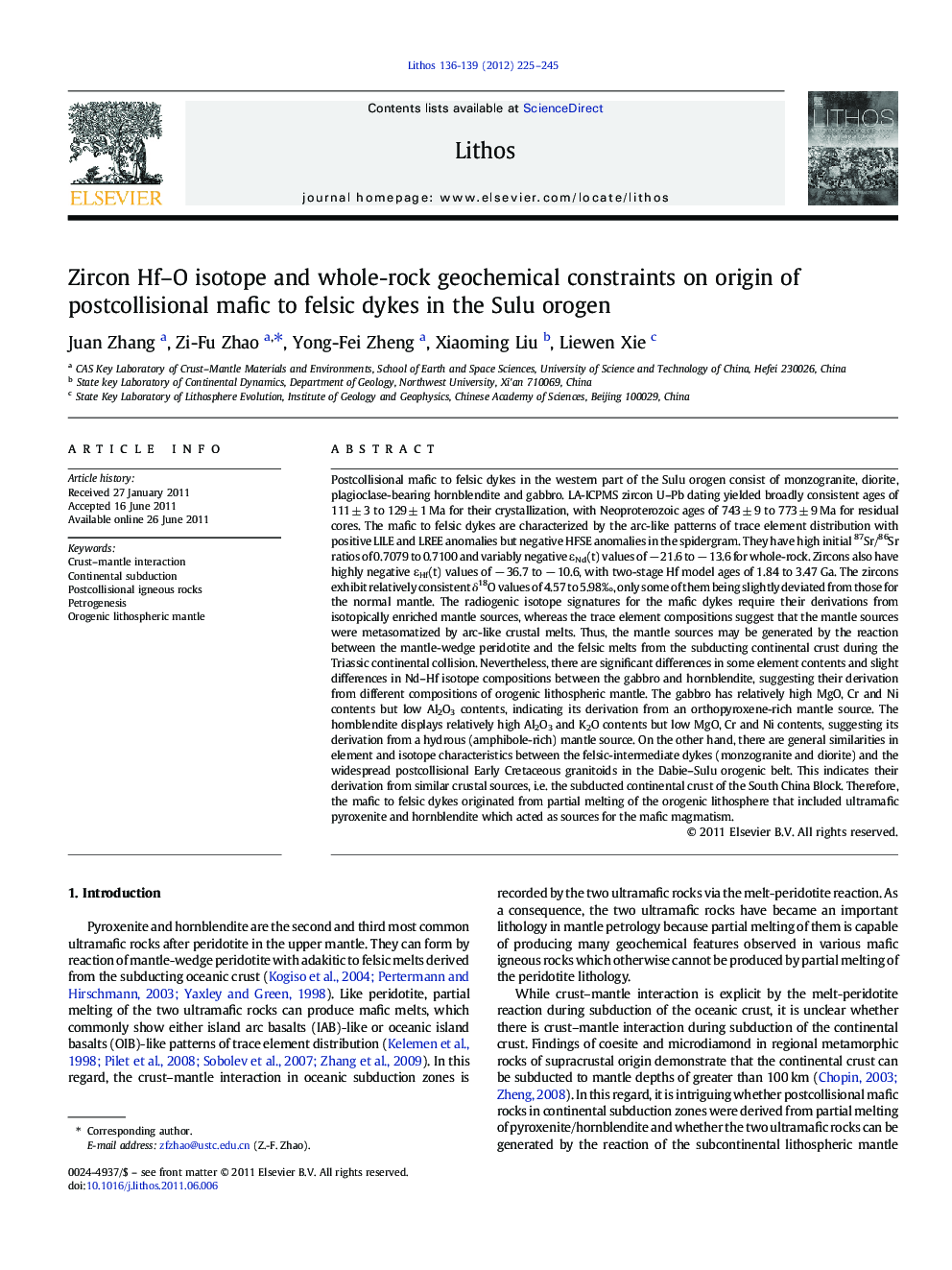| کد مقاله | کد نشریه | سال انتشار | مقاله انگلیسی | نسخه تمام متن |
|---|---|---|---|---|
| 4716650 | 1638710 | 2012 | 21 صفحه PDF | دانلود رایگان |

Postcollisional mafic to felsic dykes in the western part of the Sulu orogen consist of monzogranite, diorite, plagioclase-bearing hornblendite and gabbro. LA-ICPMS zircon U–Pb dating yielded broadly consistent ages of 111 ± 3 to 129 ± 1 Ma for their crystallization, with Neoproterozoic ages of 743 ± 9 to 773 ± 9 Ma for residual cores. The mafic to felsic dykes are characterized by the arc-like patterns of trace element distribution with positive LILE and LREE anomalies but negative HFSE anomalies in the spidergram. They have high initial 87Sr/86Sr ratios of 0.7079 to 0.7100 and variably negative εNd(t) values of − 21.6 to − 13.6 for whole-rock. Zircons also have highly negative εHf(t) values of − 36.7 to − 10.6, with two-stage Hf model ages of 1.84 to 3.47 Ga. The zircons exhibit relatively consistent δ18O values of 4.57 to 5.98‰, only some of them being slightly deviated from those for the normal mantle. The radiogenic isotope signatures for the mafic dykes require their derivations from isotopically enriched mantle sources, whereas the trace element compositions suggest that the mantle sources were metasomatized by arc-like crustal melts. Thus, the mantle sources may be generated by the reaction between the mantle-wedge peridotite and the felsic melts from the subducting continental crust during the Triassic continental collision. Nevertheless, there are significant differences in some element contents and slight differences in Nd–Hf isotope compositions between the gabbro and hornblendite, suggesting their derivation from different compositions of orogenic lithospheric mantle. The gabbro has relatively high MgO, Cr and Ni contents but low Al2O3 contents, indicating its derivation from an orthopyroxene-rich mantle source. The hornblendite displays relatively high Al2O3 and K2O contents but low MgO, Cr and Ni contents, suggesting its derivation from a hydrous (amphibole-rich) mantle source. On the other hand, there are general similarities in element and isotope characteristics between the felsic-intermediate dykes (monzogranite and diorite) and the widespread postcollisional Early Cretaceous granitoids in the Dabie–Sulu orogenic belt. This indicates their derivation from similar crustal sources, i.e. the subducted continental crust of the South China Block. Therefore, the mafic to felsic dykes originated from partial melting of the orogenic lithosphere that included ultramafic pyroxenite and hornblendite which acted as sources for the mafic magmatism.
► Postcollisional mafic to felsic dykes in the Sulu orogen have arc-like trace elements patterns and enriched radiogenic Sr–Nd–Hf isotopes.
► The felsic rocks were derived from partial melting of the subducted continental crust.
► The geochemical characteristics of mafic rocks are inherited from their sources of orogenic lithospheric mantle.
► Reaction of the SCLM-wedge perditite with felsic melts from the subducted continental crust formed pyroxenite and hornblendite.
► Crust–mantle interaction in the continental subduction zone is recorded in the postcollisional mafic rocks.
Journal: Lithos - Volumes 136–139, April 2012, Pages 225–245